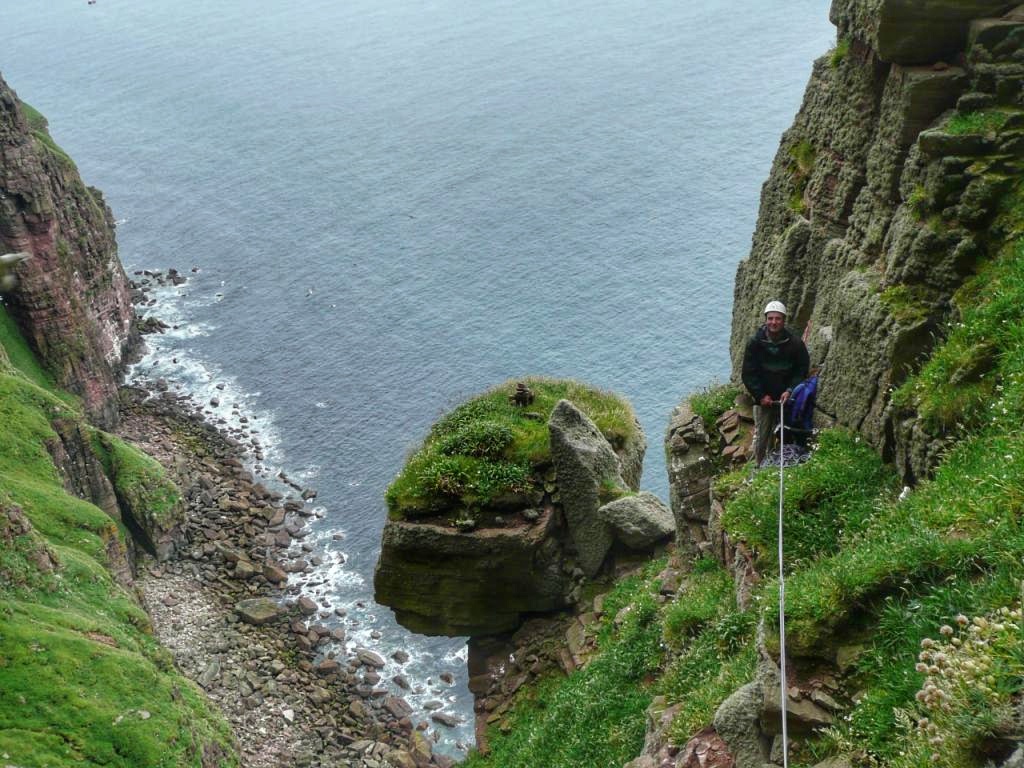
16/07/2018
It all started with a knock at the door, early one evening in July 2003. A random stranger called Les Gorham wanted to climb St John's Head and what followed over the next 5 years was a near-fanatical quest to free climb a new route up St John's Head, the UK and Ireland's highest vertical sea cliff.
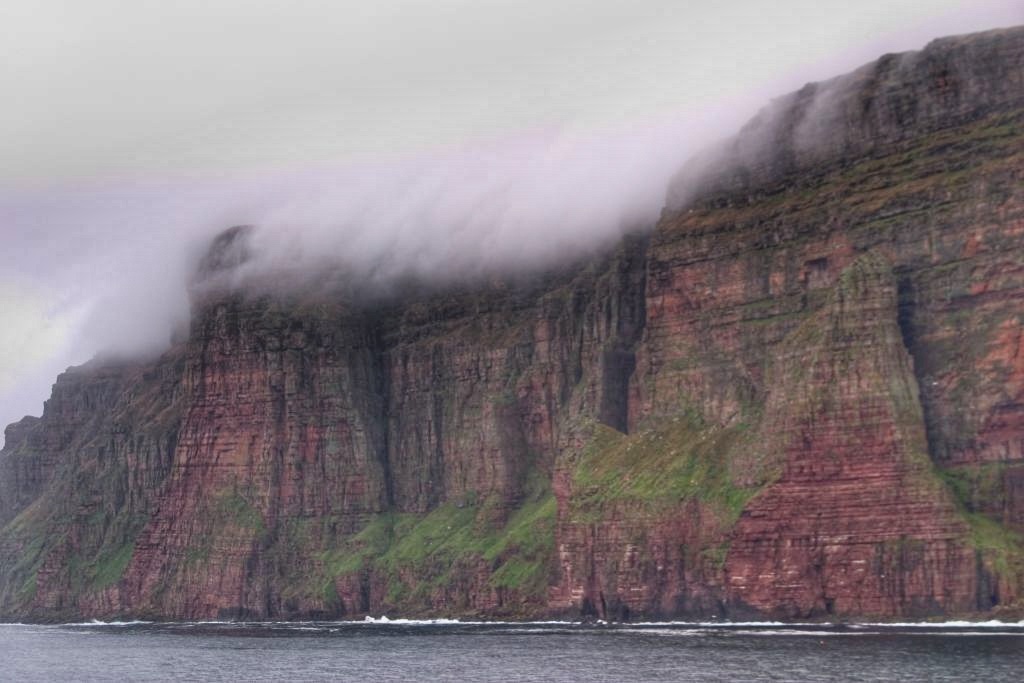
St John's Head from the Orkney to Mainland Scotland ferry
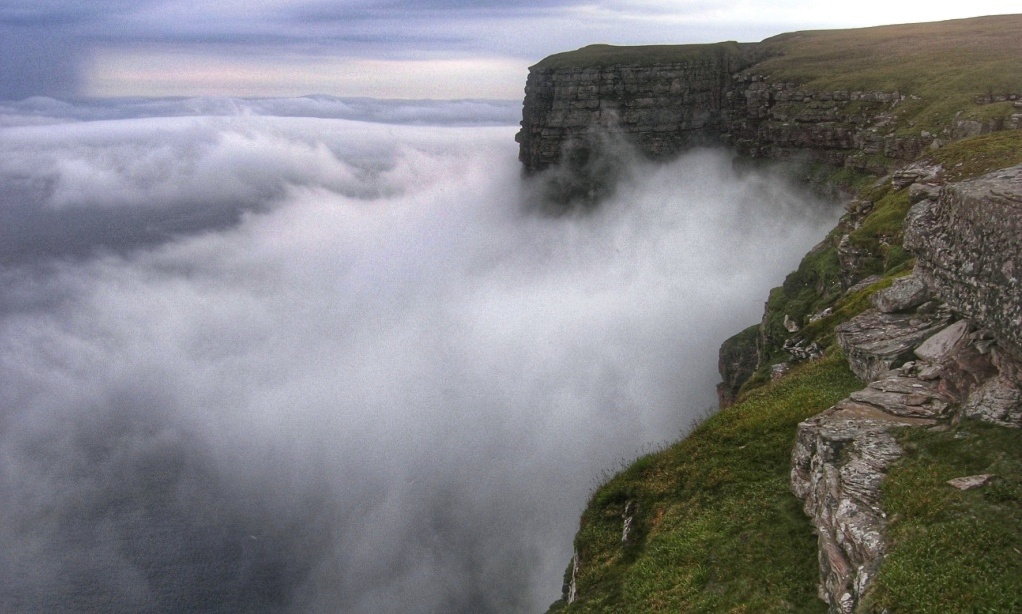
Sea Harr under St. John's Head
St. John’s Head sits approximately 3 Kilometres North East of a particularly infamous Old Man on the West coast of Hoy. The island of Hoy being the second largest of the 64 Orkney islands and its Western coastline is an almost continual 25 Kilometre stretch of the highest, most inaccessible, foreboding and “atmospheric” sandstone sea cliffs that it is possible to imagine. The highest part of this coastline is St. John’s Head and at 350 vertical meters from sea level to its summit, it is indeed a monster! Due to its isolated location accessing the base of the cliff is a major exercise in logistics and planning. The cliff summit is a 2-hour walk from Rackwick Bay (the nearest road end) following the clifftop path passing along the way The Old Man of Hoy. This takes you to the summit of St John’s Head, from here things begin to get silly! The descent “path” to the base of the cliff is a 600-meter near-vertical bulrush solo, scrambling down through primary jungle with a40meterabseil through a waterfall to arrive soaking wet and exhausted, all the time carrying a “Yosemite” sized rack! The descent from the summit to sea level can take anything from 3 hours to an agonizing all-day epic.
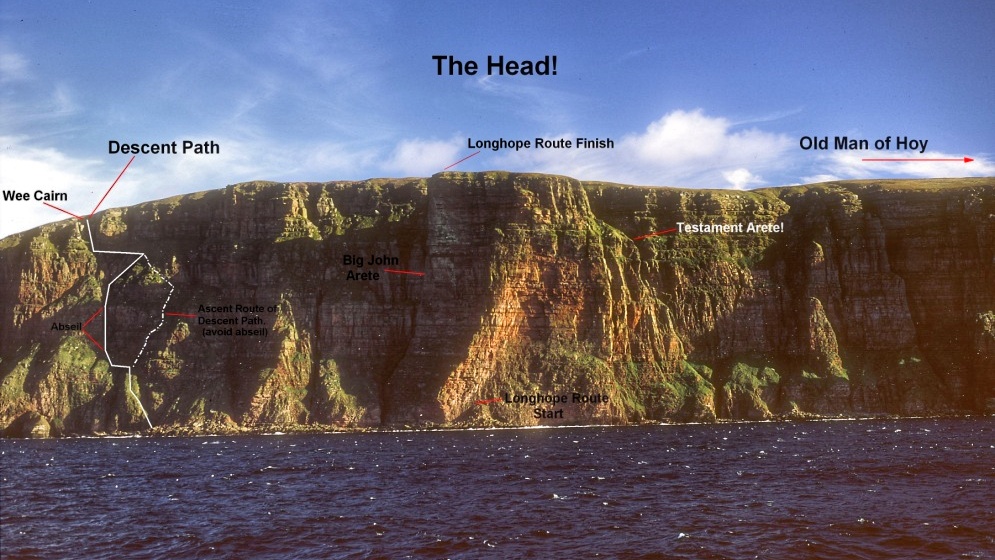
The Descent Route to the base of St Johns Head
The Head was first climbed in 1969 by The Original Route at E3 and 400 meters long this route was climbed over a continual 3-day adventure and saw the team of 5 sleeping in hammocks on ledges high above the sea. In 1970 the second route on The Head was climbed, The Longhope Route was climbed over a continual 7 day Odyssey and at E7 and 500 meters long is considered to be the daddy of adventure climbing in the UK. A third route was climbed in 1988, Big John at E5 and 435 meters long it was also a major undertaking. All three of these routes were originally climbed with varying amounts of aid and were later freed of aid with 2 of the routes waiting 27 years for a 2nd/free ascent! The first ascensionist list reads a bit like a who’s who of the British climbing scene with Dave Turnbull, John Arran, Mick Fowler and Edward Ward-Drummond all having played their part in creating/ free climbing these routes.
It was with these rather worrying statistics in mind, The Quest began.
It was in July 2004 that Derren Fox, Ross Jones, Les Gorham and myself jumped off a RIB at 4 am to be left at the base of the unclimbed south face of St John’s Head. It is difficult to describe the atmosphere of our location, the “beach” was made up of thousands of house-sized boulders and in between the boulders were thousands of ground-nesting birds, above us stood over a quarter of a vertical mile of unclimbed, overhanging and seriously decaying ancient red sandstone and thus we had entered The Realm of the Senses.
We racked up in silence as Derren led off up the first pitch of vertical grot, the first 3 pitches consisted of friable wet rock and near-vertical grass. Derren, Ross and I were alternating leads whilst Les carried a specially modified TV camera. Camped on the clifftop was Howard Clarke, he was operating a second camera and thus our activities were immortalized on film. The top of the third pitch took us to the bottom of the south face at about 90metresabove the sea. Pitch 4 was a 55-meter horror show up a bulging green chimney followed by a spot of faith climbing up vertically stacked rubble, this took us to a superb ledge and at this juncture, the sun came out. HURRA! The next two pitches took us up another 80 meters of mixed ground consisting of a mixture of good rock and primary jungle. We were now standing at the top of pitch seven and above us, the next 45 meters of rock would turn out to be the crux of the route. Off crept Mr Fox up the steep and frighteningly loose rock, he was following a natural flake line, and for the next hour, he stealthily made his way upward, picking off the loose rock and dropping them 600 feet onto the beach below. The tension was all too apparent as he reached for a distant hold and off he popped, taking a 25-foot whipper, plummeting downward as gear ripped and rocks fell before he slammed alarmingly into the rock face far below his previous high point. Outstanding performance for one so young and all captured on video by Les! There was a look of grim resignation on his face as he casually remarked whilst hanging from the ropes.
“Would anyone care to lead through this pitch?”
The silence was deafening as the three of us looked at our feet and waited for Derren to continue the pitch!! The bruised but still functioning Mr. Fox returned to the fray and led us to the sanctuary of a terrifyingly insecure ledge on the very edge of the abyss. It was now 10 PM and we were 290 meters into our route on the irreversible ground, emotions were running high as the endorphins flowed, the sun was setting fast and so, we pressed on upward into the darkness. The next 45 meters climbed a superb groove with some athletic moves through a wee roof, alas as Ross led this pitch we were being rained on below him on our exposed ledge by brick-sized rocks as he climbed the vertically stacked rubble above the roof. A character-building half-hour was had in the semi-darkness as the continual thump of falling rock around and between us continued! Thankfully “climb when ready” was called and one by one we climbed in the light of our head torches through the darkness to Ross.
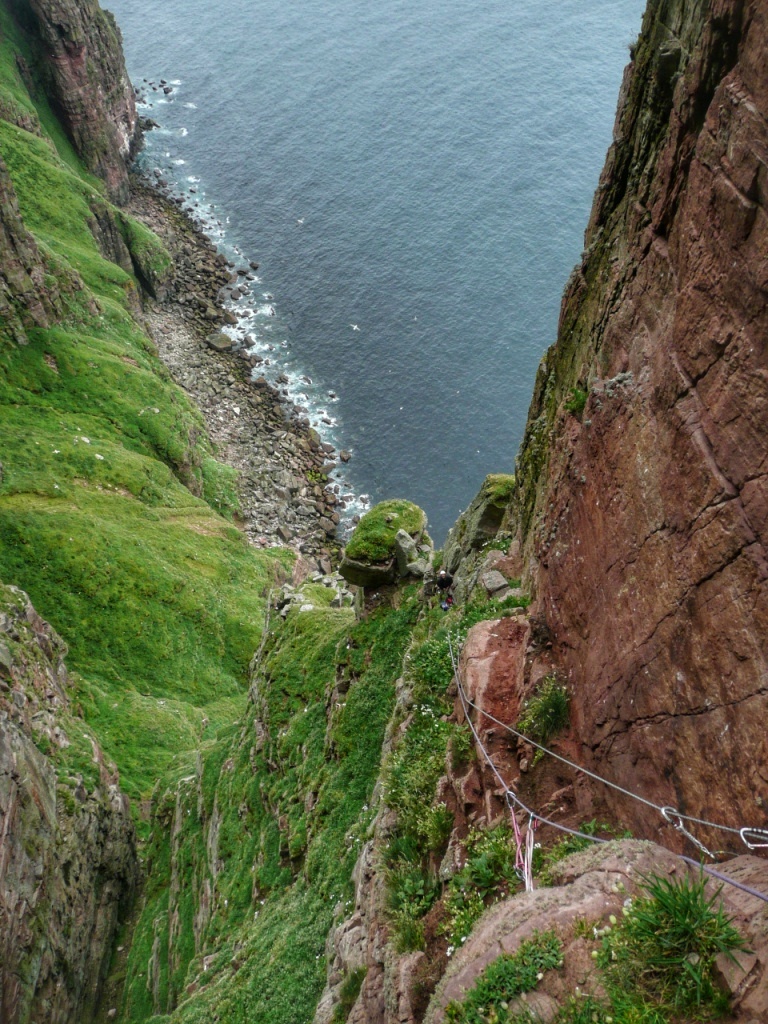
Looking down on Pitch 8
Derren Just before the fall
It was now midnight and Ross was sitting in a cave below a monstrous boulder, this was our home for the next 4 hours of darkness. It was cold, it was very, very, very cold, as we each lay in silence. Our “lightweight” bivvy gear consisted of bin bags, and there we lay wrapped in bin bags, in a cave, 340 meters up our route above irreversible ground as the clouds drew in and the drizzle started, a truly surreal experience!
With a distant hint of daylight on the horizon at 4 am we began to organize ourselves for the push to the summit, the monstrous rack was rearranged, the ropes were sorted and the flapjack was finished. The first pitch of the day was 50-meter wade through soaking wet waist-high reeds to the base of the upper headwall. I was last to leave the bivvy cave and as I waded through the saturated reeds I felt safe in the knowledge that it was all forgotten that it was my lead next. It was 5 am as I arrived to join the other three at the belay below the upper headwall, the early morning rain stopped and around us in the middle distance rain continued to lash the countryside!
“Your lead!” Beamed Ross.
For the next 4 hours, we climbed the awesome fault line up the centre of the 90-meter upper headwall in four superb pitches. Each of the four pitches up the headwall was entirely different a roof, a chimney, a hand crack, an off-width and the odd cheeky crimp made for excellent climbing on excellent rock. Standing on the belay stances between pitches on this headwall our location and situation on this huge face were absolutely awesome, stretching for kilometres either side of us lay the ominous monster cliffs towering over the Pentland Firth and 300 meters below us the Atlantic Ocean battered our previous days landing “beach.” One by one we ascended the headwall to arrive on the windblown summit and so “Testament to the Insane” at 477 meters long and graded XS 5B was born. The rain in the form of horizontal rods arrived 5 minutes later and lashed down for the next 6 hours as we descended to Rackwick Bothy carrying all the toys!
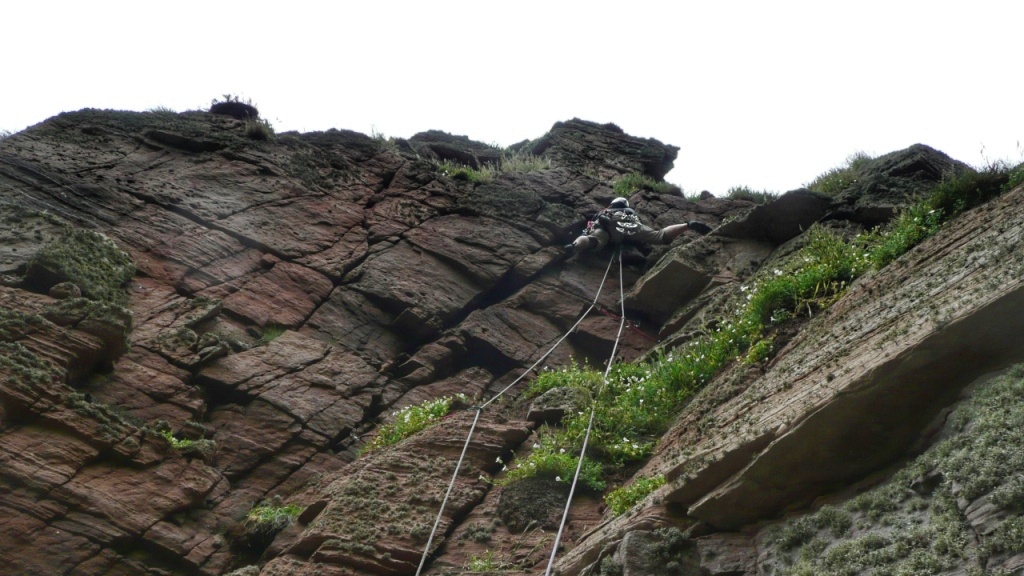
Ross on Pitch 10
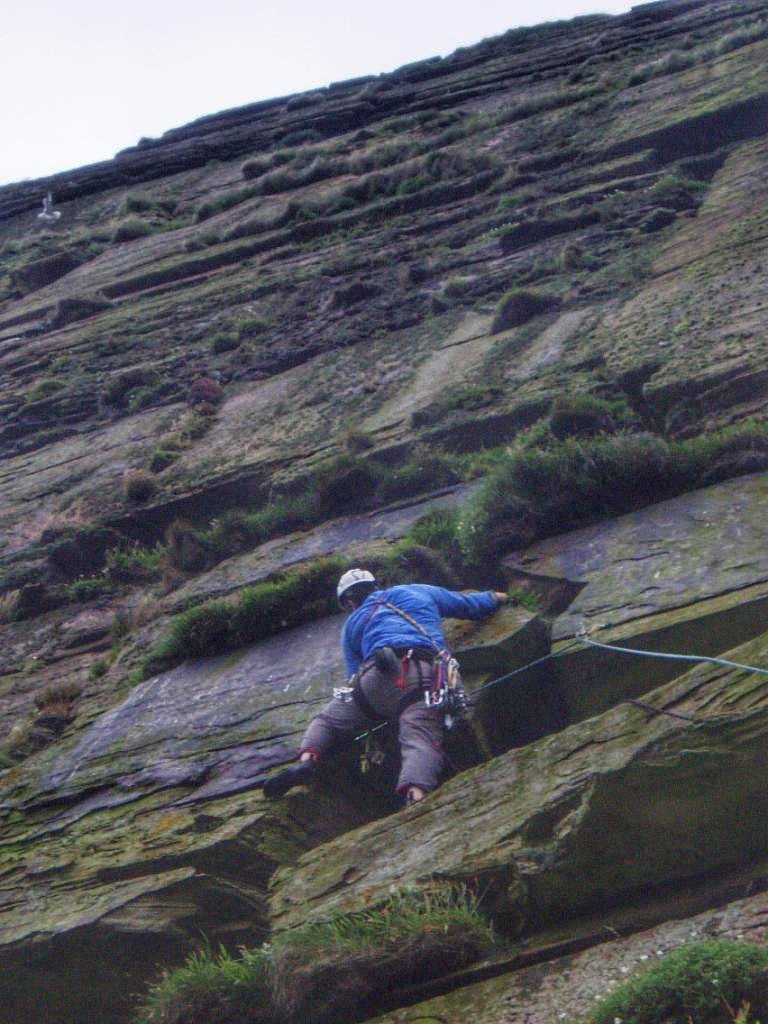
On the Headwall of St John's Head
Ross at the top of Pitch 13
An Attempt to Free
I kind of thought that this was the end of my relationship with St John’s Head, then out the blue in February 2007, I received a very short E-mail from Noble Brother Jones it simply said “The Head?” and so the Quest continued…..
June 2007, and we were back in Orkney, this time a much more lightweight approach was the order of the day, just Ross, myself and a humungous Yosemite size rack between us. On the cliff tops our ever-present watchers in the sky, Howard Clarke and Mick Tighe were in attendance to activate a rescue if things went pear-shaped. The object of this years exercise was a new route up much more intimidating ground slightly to the North of the “Testament to the Insane” arete. We camped on the summit and at an unsociably early hour we descended the “goat track” to the base of St. John’s. This descent “path” is actually a 2000ft near-vertical bulrush solo followed by a 40-meter abseil through a waterfall, this allowed us to arrive at the base of the North Face of the Head at 6 am, absolutely exhausted and soaking wet. Over the next hour, we travelled 500 meters south over the massive boulders and ground nesters to arrive at a final impasse. A final 100-meter section of coast was non-tidal and so we stripped off and swan/boulder hopped to the base of the south face. And Lo, standing in this special place again the heavens opened, our proposed new route became a waterfall and we decided to bail. For the next 6 hours, we re-swam the non-tidal section and re-ascended the bulrush slopes.
NEVER EVER AGAIN was the mantra as we retreated!
It is safe to say the ascent of the “goat track” is on the very edge of sanity, as you solo up through the waist-high vegetation your only protection from a fatal fall is the handfuls of vegetation you grab as you ascend the 400-meter cliff side.
So to summarize our 48-hour adventure on St John’s Head we had descended and ascended 4000 ft of near-vertical bulrushes, swam 200 meters in a truly outrageous location and abseiled down a waterfall, we hadn’t actually done any pitched climbing but had a superb and full-on adventure!
Upon leaving Orkney and returning to Donegal I solemnly vowed NEVER TO RETURN TO St John’s Head! Yep, I would NEVER EVER RETURN TO St John’s Head!
First Free Ascent
July 2008, and we were back in Orkney again a lightweight approach, just Ross, a big wall rack and myself. We enlisted the help of Kevin Heath and his 125 hp RIB and a 4 AM start once again saw us at the base of the South face of St John’s. Alas due to the generally poor summer's weather our chosen new route was damp (resembling a waterfall) and very green looking, so by default, we decided to re-climb the Testament to the Insane arete. For the next 12 hours, we climbed the original 16 pitches in a more sensible 13, made the route more direct by straightening the first and last pitches and free climbed pitch 8 by removing the original aid point. Climbing the route this time was a much more relaxed affair and I for one felt that I was now finally at peace with the mighty St. John’s Head.
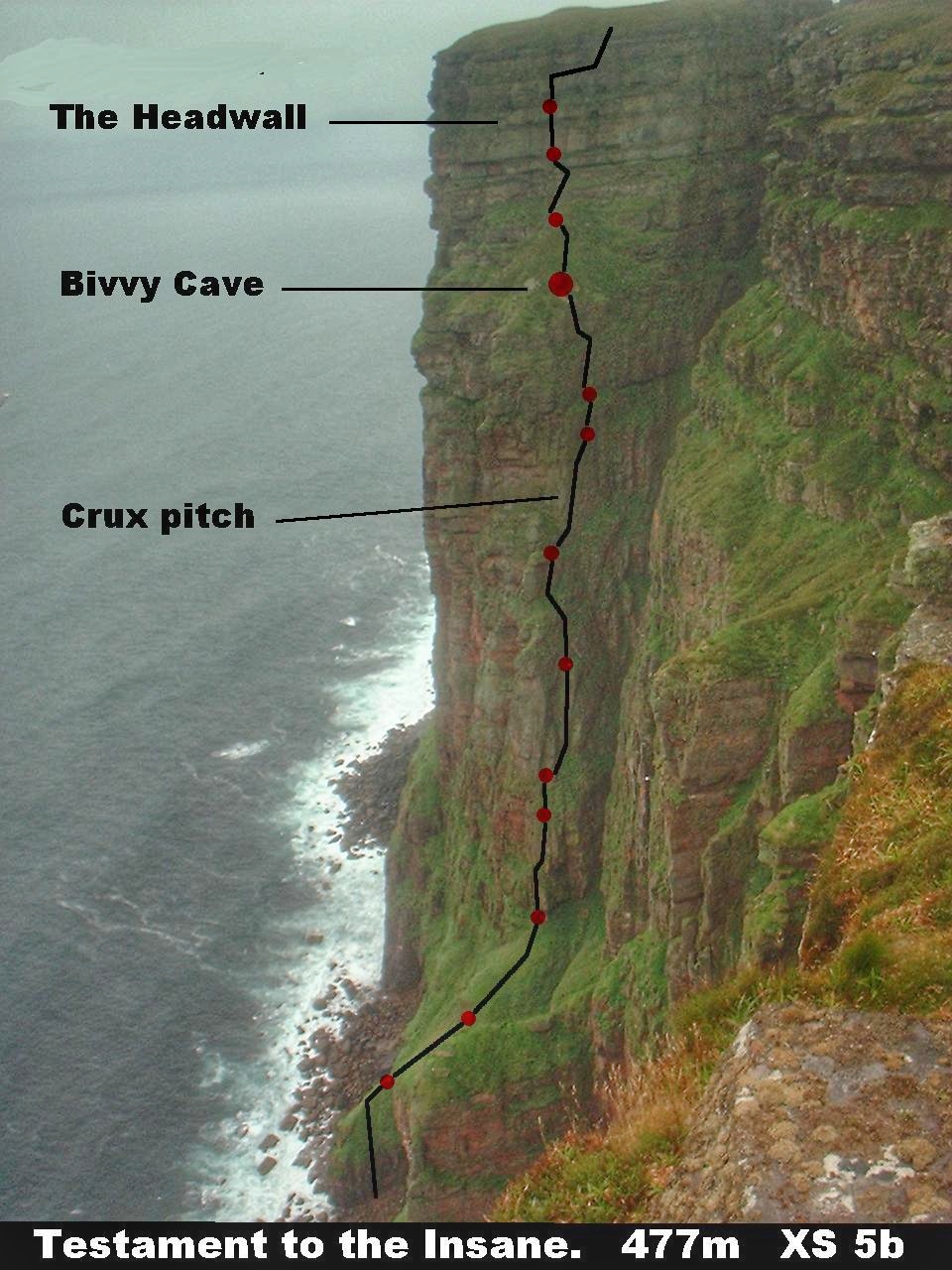
St John's Head Topo
Route Description
The headland of St John’s terminates as a huge steep stepped arête at its southern end. This feature is the largest and most obvious feature on the headland and is easily seen from the Orkney to Scrabster ferry. Access to the route is gained by a scramble from the descent gully along the beach below the main face. A short section below the main face is only accessible at low tide. Alternative access is by boat in calm seas.
Testamentto the Insane 470m XS 5b
The route was first climbed in 2004 in a single 26-hour push with a short bivvy during darkness. An 8m leader fall was taken on pitch 8 and one point of aid used on lead, the pitch was then free climbed at 5b by the 2nd. .
In July 2008 the route was repeated in 12 hours, more direct first and last pitches were taken and the aid removed from pitch 8.
The rock quality is in general poor but the location and the atmosphere is truly outstanding an adventurous and serious route.
Pitch 1. 30m To the left of the boulder beach, directly below the arête, climb the short seaward wall of excellent rock and scramble to the only boulder and prominent scar.
Pitch 2. 35m Scramble easily up the grass to the rock band, belay in cracks at its right-hand end.
Pitch 3. 40m Continue up the steepening grass to the base of the towering arête, belay at the bottom of the big chimney/groove.
Pitch 4. 55m 5a Climb the chimney/groove, pull out left at its top to a sloping grassy stance. Climb up steep ledges to another groove and pull out through the roof at its top and follow the short corner/wall to a small stance. Continue up a grassy arête on the right to a superb ledge at the bottom of a right-facing corner
Pitch 5. 40m 4a From the right-hand end of the ledge climb the slabby right-facing corner to easier ground, ascend this swiftly to a second right-facing corner, climb this to a good stance. Belay in the cracks on good rock.
Pitch 6. 40m 4b Climb up trending left gently to the base of a steep red wall below a huge precarious capping boulder. Traverse right hand and ascend the steep ramp on the better rock to a steep and extremely loose vegetated slope. Climb this delicately to the landward side of another massive perched boulder. Belay in the twin cracks on the wall below it.
Pitch 7. 45m 5b Traverse along the grassy ledge to the bottom of the prominent arête, which bounds the right-hand end of the huge slabby upper wall. Pull around the arête on good holds in an exposed position to gain the base of a left-facing corner. Climb the corner steeply to an exposed ledge (several pegs) and belay at the back below a wide groove.
Pitch 8. 12m 4a Climb up the wide groove and up grass to a good stance. In situ peg and gear belay.
Pitch 9. 45m 5a Climb the steep right trending corner through a wee roof to steep vegetation. Climb this to a recess on the left. Climb the centre of the recess to a huge boulder and belay. Bivvy on the first ascent.
Pitch 10. 48m Scramble through deep vegetation to the bottom of the headwall. Belay on the high point of vegetation directly below the huge central fault line.
Pitch 11. 25m 4b Climb the left-facing corner on the left and up to and into a cave with a huge block on the floor, Climb through the niche in the roof of the cave to the bottom of a big left-facing corner. Good flake belay at bottom of the corner.
Pitch 12. 20m 5a Climb the hand crack 3 meters to the left of the vegetated open book corner to a good triangular niche. At the back of the niche climb the steep hand cracks to a good stance on the left. Belay in sight and sound of others.
Pitch 13. 35m 5a Continue up direct in classic chimney fashion to the summit.
First Ascent Derren Fox, Ross I. Jones, Iain Miller, (Alt. Leads), Les Gorham. 23-24 July 2004
First Free Ascent Ross I Jones, Iain Miller. 09/07/08
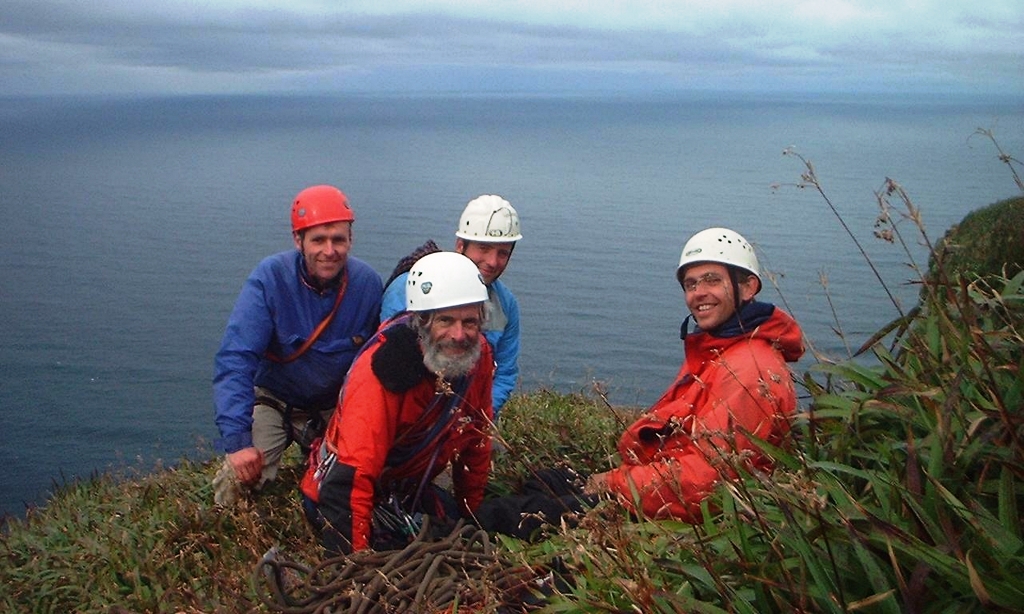
Summit team on St John's Head
In memory of Les Gorham who died in an abseiling accident at the base of an Orkney sea stack, two days after ascending St. John’s Head in 2004.